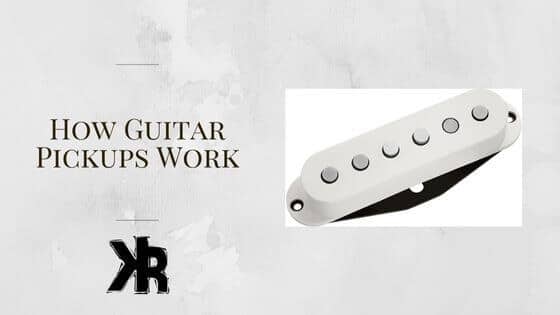Table of Contents
Guitar pickups are a complex and fascinating technology! They ultimately lie at the heart of the electric guitar.
These devices use magnets and wire coils to amplify the guitar’s string vibration. But how exactly do pickups work, and what makes one sound different from another?
Understanding how guitar pickups work can help you get the most out of your instrument. This way, you can shape your sound exactly how you want it.
In this Killer Rig article, we will look into the anatomy and science behind guitar pickups. Exploring the role of magnets, wire coils, and other components in shaping the sound of the guitar.
What Is a Guitar Pickup?
A pickup, in its most basic form, is a detection device installed on the body of an electric guitar. Sometimes even a few of them.
A pickup’s job is to capture the vibrations of the guitar’s strings. It then converts them into electrical energy. It can now be processed by an amplifier or other device.
The signal it produces is useless otherwise. Pickups are crucial for the electric guitar! This is because they provide the sound we hear when we connect them to an amplifier.
How Guitar Pickups Work
A guitar pickup is an electromechanical transducer. Or, if you prefer, an inductive sensor. It captures and converts the vibrations of the strings into an electrical signal. That signal can then be amplified. The core of a pickup is a magnet that creates a field around itself.
Once a metal object such as a guitar string enters the field, it too will become magnetized. When the string vibrates, this causes the magnetized field to move.
In turn, it induces an electrical current in the coil of wire that surrounds the pickup magnet. This phenomenon is called electromagnetic induction.
Lean how to clean guitar pickups here!
The Science of Induction
Induction is the process by which an electrical current is generated in a conductor. It’s a result of a changing magnetic field around it.
This was first detailed by scientist Michael Faraday in the early 19th century. It remains the basis for how guitar pickups work.
Induction is a fundamental principle of electromagnetism. It plays a crucial role in the operation of many electronic devices. Outside the guitar realm, this includes motors, generators, and transformers.
For guitar pickups, it’s what allows them to capture and amplify string vibrations. Turning them into an electrical signal that can be shaped and modified to produce a wide range of sounds. Even painted pickups won’t interfere with the signal.
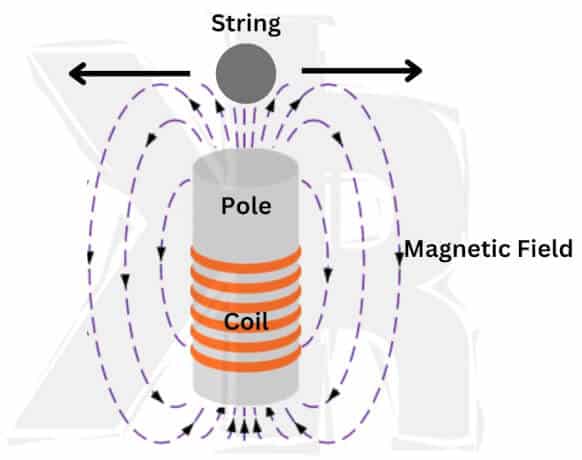
Output Level and Tone Quality
The output level and tone quality refer to the strength and character of the signal. Not every pickup produces the same sound or output.
These factors are determined by the construction and materials of the pickup. Not to mention the position of the pickup on the guitar.
Signal Intensity
The output level is typically measured in millivolts (mV). This is the strength of the electrical signal that is produced by the pickup. A higher output pickup will produce a stronger signal, as one would assume.
This is useful for driving amplifiers and effects pedals to produce different results. One negative to a hotter output is that it may also result in a higher level of noise.
On the other hand, a lower output pickup will produce a weaker signal. This is better suited for clean and subtle tones. But it may also struggle to drive pedals and amplifiers effectively.
The output of the pickup is also a result of the number of wraps in the coil. The more wraps, the greater the output. The fewer wraps in the coil, the smaller the output will be.
Want to learn how to set pickup height? Click here!
Characteristics of Sound
Both single-coil and humbucking pickups have certain sonic qualities. The guitar’s overall tone can be considerably impacted by the pickups that are used. This is a result of the materials used in their construction.
The position of the pickup on the guitar also contributes to the sound. Closer or farther from the center of the strings makes a difference.
But the materials and design cannot be overlooked. The choice of magnets and even wire can determine the final tone.
Even the way the wire is wound around the bobbin or magnets will provide intricacies in the sound. More wraps of wire will produce a darker sound. While fewer wraps will result in a thinner, brighter tone. Let’s explore some of these traits.
Magnet and String-Centric Models
If you’ve done a bit of research, you will have by now seen two different theories presented. The magnet and string-centered models.
These are two arguments on what is happening to the magnetic field when it comes to guitar pickups. Only one can ultimately be true.
One perspective says that the magnetic flux is being disrupted by the string. In turn, a current is produced in the coils. This would mean that the field is only being disturbed by the string. That the string is not becoming magnetic itself.
The other theory is that the string is becoming magnetized. This new magnetic field around the string itself is what is exciting the coils. The National High Magnetic Field Laboratory has an interactive visual to help understand.
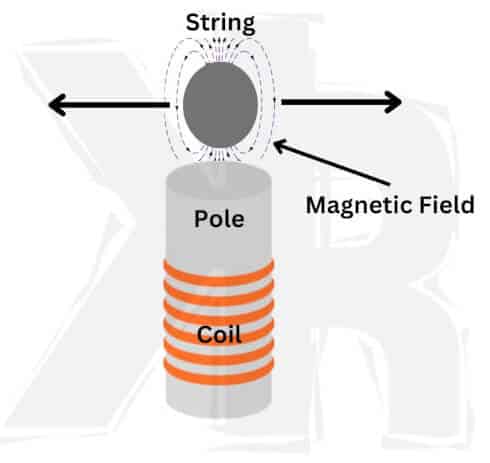
So which one is true? Well, based on science and testing, the string-centric model does prove to be true. If you have ever had a pickup die in a guitar, in some cases it’s because the magnet has weakened. You no longer get sound.
Or, it has become very weak. So we know that the magnet is playing a big role here. But when restoring a magnetic field to the string alone, your sound will return again. So this makes the string-centric model the more prominent argument.
The Anatomy of a Guitar Pickup
Guitar pickups are comprised of several key components. This includes pole pieces and magnets, metal covers, copper wire coil, and inner wiring. The pole pieces and magnets form the core of the pickup.
They generate a magnetic field that interacts with the strings. This is usually found in either single-coil or humbucker configuration.
The metal cover surrounds the entire structure. It helps to reduce unwanted noise from external sources. Copper wire is then wound around this core structure, which is connected to an output jack. Unless the guitar has controls that help with sound shaping.
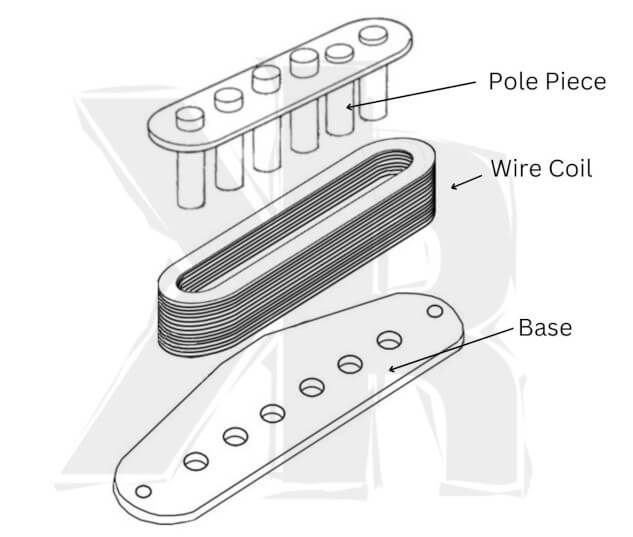
Coil Winding and Bobbins
You will also find a coil of wire or two. These are bobbins wrapped with wire that react to the magnetic field. When a string is vibrating, a current is created and a signal produced as a result.
Two coils of wire coupled in opposing polarity make up humbuckers. This serves in removing any undesirable buzz or noise from the output. Single coil pickups on the other hand only have one. They are quite noisy as a result.
Winding bobbins and the tension of the wire also has an impact on the sound of the pickup. Tighter wire tension will produce less noise and a warmer sound. It also provides more room for additional wraps.
A looser tension will allow for noise and feedback. This is because it leaves gaps that almost begin to act like a microphone. But it also allows for a brighter sound if you desire it.
Common Magnets Used in Pickups
Guitar pickups are typically created from either one or multiple magnets. There are a few main types of magnets used in guitar pickups. Each with its own characteristics and qualities.
Alnico magnets are the most common and come in several grades. This ranges from Alnico 2 (softest) to 5 (hardest).
These magnets produce a warm, vintage sound and are popular choices for blues and classic rock tones.
Ceramic magnets are generally harder than Alnico. Therefore, they create brighter tones with more clarity and articulation.
They also have higher output levels compared to other magnet types. It makes them ideal for heavier genres like metal.
Other common magnet types include neodymium and samarium-cobalt-iron combinations. They offer enhanced clarity and responsiveness, as well as increased sustain capabilities.
Guitar pickup magnets also play a huge role in the signal intensity they produce. The larger gauss strength improves induction. This ultimately results in a stronger output from the pickup.
Check out our detailed article on pickup magnets here!
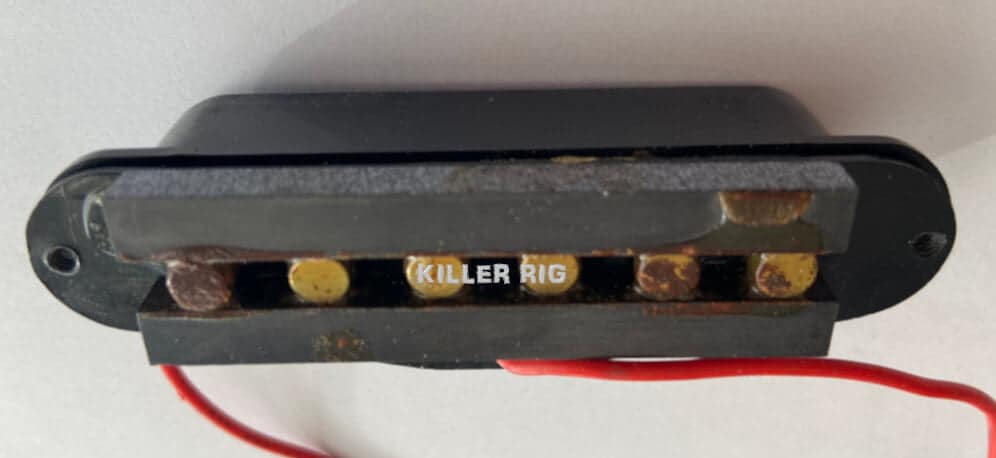
Guitar Pickup Potting
Pickup potting is a process used to protect and ensure they produce reliable sound. This involves submerging the pickup in a wax or epoxy compound. It hardens over time to form a protective casing around the pickup.
The potting helps to reduce unwanted resonance and feedback. The copper wire is permitted to vibrate. So gaps between windings can create undesired noise and interference.
A pickup’s coil may be so loosely coiled that it can practically pick up sounds like a microphone. Potting prevents this. While also protecting the pickup’s internal circuitry from moisture and dirt contamination.
What do you prefer? Active or passive pickups? Click here!
Single-coil and Humbucker Pickups
Single-coil and humbucking pickups both use the same basic design principle. Capture string vibrations and convert them into an electrical signal. But there are many differences between the two designs that affect their sound.
Single-coil pickups have one coil of wire wrapped tightly around a metal core. They have 6 pole pieces that run through the middle of each coil.
The single coil produces bright, cutting tones with plenty of detail. But it’s more prone to picking up unwanted noise such as hum or radio interference.
Humbucker pickups employ two coils wired out of phase with each other. This cancels out any extraneous noise, resulting in a much higher signal-to-noise ratio.
The tone produced by humbuckers is usually fuller and richer than what you would get with a single-coil pickup. Although it may lack some of the clarity if designed to be bass-frequency heavy.
Each kind of pickup has its own characteristics. They are all well-suited for different playing styles and genres. It’s important to consider which one will best achieve your desired sound. Well before making a purchase.
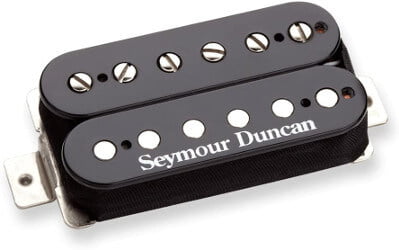
Conclusion
You should now be aware of how a guitar pickup operates. Why the strings themselves are not simply magnetized may be a mystery to you.
And some individuals have inquired about this after learning about the string-centric concept. But in reality, it would cause problems for the player.
First, you may have metal shavings stuck to your strings. Your fingertips would suffer because of this.
Plus, an electrical charge would have to be applied to the string. This itself would be hard to maintain. At the end of the day, the pickups we use work fine and sound great! No need to fix something that’s not broken!

